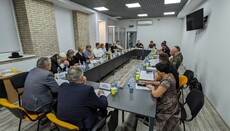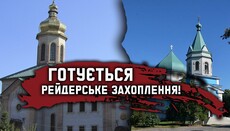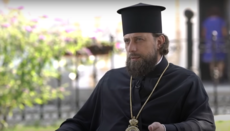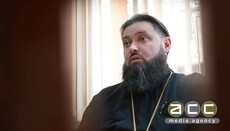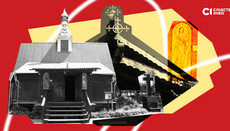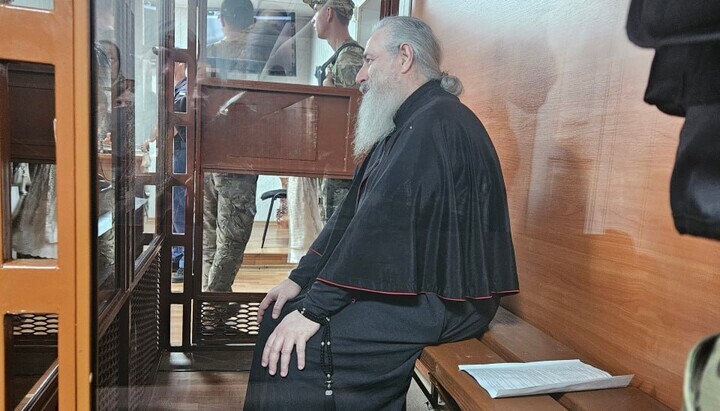Theological Commission of UOC comments on the issue of mobilization
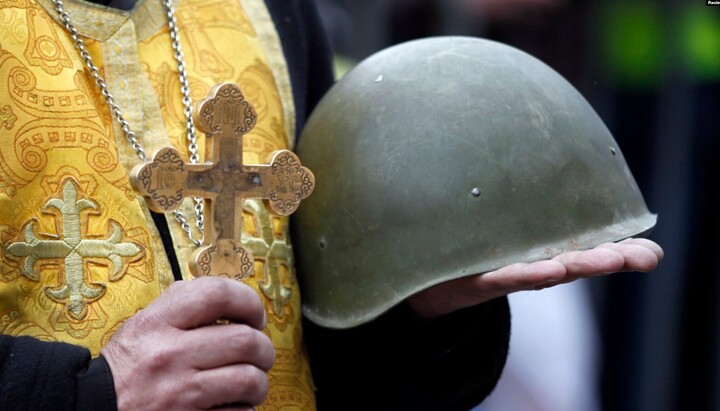
Every clergyman of the Ukrainian Orthodox Church must determine the nature of his service in wartime strictly within the framework of church canons.
The Theological and Canonical Commission of the Holy Synod of the Ukrainian Orthodox Church, at its meeting held on June 19, 2024, by the blessing of His Beatitude Metropolitan Onuphry of Kyiv and All Ukraine, prepared conclusions regarding the military mobilization of clergymen.
The UOJ publishes the full text of the document with reference to the website of the UOC Information and Educational Department:
"The Theological and Canonical Norms Regarding the Military Mobilization of Orthodox Clergy under the Law of Ukraine 'On Military Duty and Military Service'."
In connection with the armed attack of the Russian Federation on Ukraine, the Theological and Canonical Commission of the Holy Synod of the Ukrainian Orthodox Church, guided by the "Foundations of the Social Concept of the Ukrainian Orthodox Church," notes that "the Church... does not prohibit its children from participating in hostilities when it comes to defending neighbors and restoring violated justice... Orthodoxy has always held warriors in high esteem who, at the cost of their own lives, protected the lives and safety of others. Many warriors have been canonized by the Ukrainian Orthodox Church, taking into account their Christian virtues..." The Ukrainian Orthodox Church, from the first day of the full-scale invasion of Russian troops into Ukraine, has called for and continues to bless and pray for all its faithful children serving in the ranks of the Armed Forces and other military formations of Ukraine, and suffers with them, for as the Apostle says: "If one member suffers, all the members suffer with it" (1 Corinthians 12:26). Recognizing that victory over the enemy and peace in our land are God's blessings, the Ukrainian Orthodox Church in all its parishes across our State offers humble prayers to the "King of kings and Lord of lords" (1 Timothy 6:15), remembering the words of the Lord Jesus Christ that: "If two of you agree on earth concerning anything that they ask, it will be done for them by My Father in heaven. For where two or three are gathered together in My name, I am there in the midst of them" (Matthew 18:19-20). In its interpretation of these words of the Lord, the tradition of the Orthodox Church notes that they speak of church prayer, which, according to the teaching of the Orthodox Church, is impossible without the priesthood, as the New Testament priesthood is an image of the One True High Priest, our Lord Jesus Christ (see Hebrews 7:23). Accordingly, without the priesthood, there is no Church.
From the "royal priesthood," which, according to the Apostle, all the faithful of the Orthodox Church are (see 1 Peter 2:9), a clergyman is distinguished by the special grace of the All-Holy Spirit bestowed upon him during ordination. This special character of grace and the very essence of priestly service have, since apostolic times, determined that receiving the grace of the priesthood and the continued ministry of a clergyman must be conditioned by a number of canonical requirements. One of the foremost of these is the absolute prohibition against committing murder and, consequently, participating in combat, which involves the use of weapons. A clergyman, who is a bearer of the special grace of the Holy Spirit, Who is not only the Chief of the Mysteries (τελεταρχικός) but also the Giver of Life (ζωῆς χορηγός), cannot in any way shed blood and take life.
As already mentioned above, the incompatibility of the sin of murder with serving in the holy orders is noted as early as the Apostolic Canons (59th, 66th)[2]. The 59th Apostolic Canon equates the cruelty of a cleric who refuses to help his neighbor with murder and, accordingly, punishes it with deposition (καθαίρεσις). Saint Nicodemus the Hagiorite (18th century), in his commentary on the 66th Apostolic Canon, calls any murder a "great mortal sin" (ἡ μεγάλη καὶ θανάσιμος ἁμαρτία) and identifies it as an absolute obstacle to remaining in holy orders[3]. Following the rules of the holy fathers and their authoritative interpretations, St. Nicodemus de facto classifies the participation of a cleric in war as intentional murder (ὑπάγουν εἰς τὸν πόλεμον)[4]. This is directly prohibited by the 83rd Canon of the Holy Apostles (ἐπὶ στρατείαν ἔρχεσθαι)[5], as well as the 7th Canon of the Fourth Ecumenical Council (στρατείᾳ σχολάζειν)[6]. At the same time, it should be noted that authoritative Byzantine canonists consider not only the direct participation of a cleric in combat involving the use of weapons to be incompatible with the clergy but even military logistics (στρατιωτικῶν σιτηρεσίων, πραγμάτων) and the organization of military recruitment (στρατολογιῶν)[7] (Theodore Balsamon, 12th century).
The church-canonical argumentation regarding the complete incompatibility of military service involving the use of weapons and service in holy orders has several basic dimensions:
1) Legal Perspective: According to the "Canonical Syntagma" of St. Photius, Patriarch of Constantinople, "murder is qualified according to intent" (ὁ φόνος ἀπὸ τῆς διαθέσεως σκοπεῖται)[8]. Thus, anyone who takes up arms during wartime internally consents to committing murder and does so intentionally. Importantly, St. Photius develops this principle in the context of the 55th rule of St. Basil the Great, which calls for the deposition of a cleric who commits murder even in self-defense. The intentional or unintentional nature of the killing is determined by the type of weapon used (ἀπὸ τὸ ὄργανον ὁποῦ ἐμεταχειρίσθη, Syntagma of Photius, supplemented by St. Nicodemus the Hagiorite). Consequently, military weapons, specifically designed for killing, make a cleric’s participation in war an intentional act of murder. The principle "φόνος ἀπὸ τῆς διαθέσεως σκοπεῖται" de facto applies the norms of the 59th, 66th, and other relevant canons even to cases where the use of weapons does not result in death ("Pedalion" by St. Nicodemus the Hagiorite, commentary on the 66th rule of the holy apostles). It is worth noting that authoritative Byzantine canonists, particularly Patriarch Theodore Balsamon, emphasize the absolute nature of the church-canonical prohibition on the use of weapons by clergy, which could potentially become instruments of murder as such ("πάντη ἀπηγόρευται").
2) Sacramental Dimension: One of the main aspects of clerical service is the administration of church sacraments, primarily the Holy Eucharist. According to the 22nd and 23rd rules of the Council of Ancyra (314 AD), both intentional and unintentional murder lead to excommunication from the Holy Mysteries. The sin of murder resulted in excommunication even for leaders of the so-called "royal priesthood" of Byzantium. For example, St. Photius once excommunicated Caesar Bardas for killing his competitor Theoktistos. The 13th rule of St. Basil the Great extends the norm of excommunication to soldiers for pastoral purposes, which also applies to soldier-clerics. The norm of the 13th rule of St. Basil the Great can also be understood retrospectively through the lens of his 43rd rule, which qualifies any taking of life as murder. Accordingly, the inability of a cleric to participate in and perform church sacraments makes it impossible for him to remain in the clergy. The Eucharistic explanation of the 66th rule of the holy apostles regarding the clergy is also present in the canonical commentaries of the confessor Bishop Nicodemus Milaš (1845-1915), who notes that any bloodshed by a clergyman contradicts the very essence of the sacrament of the Eucharist as a Bloodless Sacrifice.
3) Pastoral-Psychological Dimension: This is formulated by the pastoral canons of the Orthodox Church, primarily based on the fact that the sin of murder is a canonical obstacle to receiving holy orders. This norm reaches the 61st rule of the holy apostles, which mentions "forbidden actions" (ἡ ἀπηγορευμένη πράξις) that serve as obstacles. St. Photius, in his 20th Amphilochia, among other things, refers to "hands stained with blood" (τὴν χεῖρα μιάνας αἵματι). This formulation directly corresponds to the 5th rule of St. Gregory of Nyssa (4th century), emphasizing that any murder defiles or taints a person (τὸ τοῦ φόνου μίασμα) and makes him unworthy of the priestly grace (ἀπόβλητον ἱερατικῆς χάρισματος).
The norm of the 61st canon of the holy apostles, which includes the impossibility of a person who has committed murder receiving holy orders, is interpreted by St. Photius in a pastoral-psychological context. He notes that the grave sins of fornication, adultery, and murder (τὴν χεῖρα μιάνας αἵματι) represent a crossing of boundaries by the individual, causing a deep internal "break" and disrupting their inner integrity. Accordingly, murder constitutes a "destabilization of the will" (ἐφ’ ἑκάτερα ἄδηλον τε τὴν κρίσιν παρεχομένη), which in future pastoral life could likely result in tragedy – a person who has once crossed a certain threshold finds it easier to cross it again. This disruption of balance for a long time distorts the self-consciousness of one's neighbor as "the image and likeness of God" (Gen. 1:26) and accordingly distorts the direction of the soul's rational force ("ἄλογος," St. Photius, Scholies on the Gospel of Matthew). Blessed Theodoret of Cyrus notes that the presence of common ancestors for all humanity was part of God's plan to combat the animalistic thirst for killing, which is a trait of irrational nature (Commentary on the Book of Genesis). In the patristic tradition, the psychological problem of murder is formulated, among other things, through the absolute unnaturalness of this sin: while most sins represent an illusion of overcoming one's own frailty and mortality, murder, on the contrary, only multiplies death.
In addition to the disruption of a person's psychological integrity, the church-canonical prohibition on admitting to the clergy or retaining those who have committed murder (and according to the norm of the "Nomocanon" and the commentary of St. Nicodemus the Hagiorite – also those who have participated in military actions), has a profound pastoral dimension. St. Photius, in the aforementioned Amphilochia, notes that the norm of the 61st Apostolic Canon regarding the clergy stems from the understanding of the pastor as a "model for the faithful" (1 Tim. 4:12). The prohibition against remaining in the clergy for those who have committed murder corresponds to one of the basic features of canonicity – namely, churchliness, as violating this norm creates the illusion of "double standards" and sows scandal and discord in the unified community, which for objective reasons is unable to ascertain the true repentance of the priest.
Since the canons of the Orthodox Church aim to heal and cure the human soul (see the 2nd canon of the Council in Trullo), the prohibition on clergy who have used weapons has a profound therapeutic effect. Participation in war has not only psychological consequences (post-traumatic stress disorder) but also spiritual ones. Accordingly, a clergyman who himself needs spiritual healing cannot be a healer for others (cf. Lk. 4:23). In wartime conditions, when soldiers returning from the front need quality psychological and spiritual support, ignoring the norms of pastoral canons would lead to a pastoral disaster and create a "vicious circle." This is one of the practical aspects of pastoral canons in wartime.
4) Historical-Canonical Perspective: It derives from the reception of the above-mentioned canons throughout Church history. Theodore Balsamon (12th century), in his commentary on the 43rd canon of St. Basil the Great, lists known cases where clergy were defrocked for committing murder. He specifically mentions the defrocking of a bishop who, during a war, killed a Muslim in self-defense (Ἀγαρηνὸν... ἐν καιρῷ πολέμου). The Byzantine chronicler John Skylitzes (11th-12th centuries) recalls the defrocking of a priest named Themel, who, upon hearing about the approach of Saracens (Muslims), ceased performing the Liturgy and killed several of them. Skylitzes notably emphasizes that Themel was performing the bloodless Liturgy (τὴν ἀναίμακτον… λειτουργίαν). Byzantine princess and historian Anna Comnena (11th-12th centuries) mentions her shock upon learning about a Latin priest participating in a naval battle: "We and the Latins do not have the same views on priesthood," she remarks in her memoirs. These testimonies are exceptionally important for the historical-canonical justification of the absolute prohibition on clergy participating in combat, as Byzantium predominantly fought defensive wars during the 11th-12th centuries.
It is worth noting that even during turbulent periods in human history, when some clergy consciously ignored certain church-canonical norms amid national liberation struggles, the Orthodox Church always returned to the realization of the immutability of pastoral canons and their clear theological justification. A vivid example is the Greek War of Independence (1821-1829) and the drafting of the Greek Constitution of 1827, in which, for the first time in modern history, church canons were officially defined as the normative legal basis for developing state-church relations. Article 24 of this Constitution established the incompatibility of remaining in holy orders with any political or social activity or position prohibited to the clergy by the canons of the Orthodox Church. Among such canons, theologians of the Church of Greece point to those that prohibit clergy from participating in combat. These include the aforementioned 7th canon of the Fourth Ecumenical Council and the 83rd Apostolic Canon, which argues this incompatibility with the words of the Lord Jesus Christ: "Render therefore to Caesar the things that are Caesar's, and to God the things that are God's" (Matt. 22:21). Retrospectively, the formulation of this canonically justified article of the Greek Constitution was significantly influenced by those clergy who, contrary to the canons, engaged in active political or military activities at the start of the revolution. From a church-canonical standpoint, the emergence of this article was due to the a priori understanding that in the canonical law of the Orthodox Church, there is no precedent norm, and it served as a testament to fidelity to canonical order.
Accordingly, any clergyman of the Ukrainian Orthodox Church must determine the nature of their service during wartime strictly within the framework of church canons, based on the provisions of the priestly oath they have taken. This adheres to the basic church-canonical principle: a clergyman can under no circumstances participate in combat, use weapons, or shed blood, as they are appointed by the Church to lift up "holy hands, without wrath and doubting" before the Throne of God for the rest of their life (1 Timothy 2:8).
It is particularly noteworthy that the strict observance of all church-canonical requirements regarding the clerical state is a fundamental premise for preserving Orthodox priesthood. This is necessary not only for the pastoral care of those soldiers currently in active combat zones or on leave after being wounded, but also for those who will permanently return to civilian life after the victory of the Armed Forces of Ukraine and will need rehabilitation and proper spiritual support.
As the UOJ previously wrote, the Vatican criticized the mobilization of priests in Ukraine.
